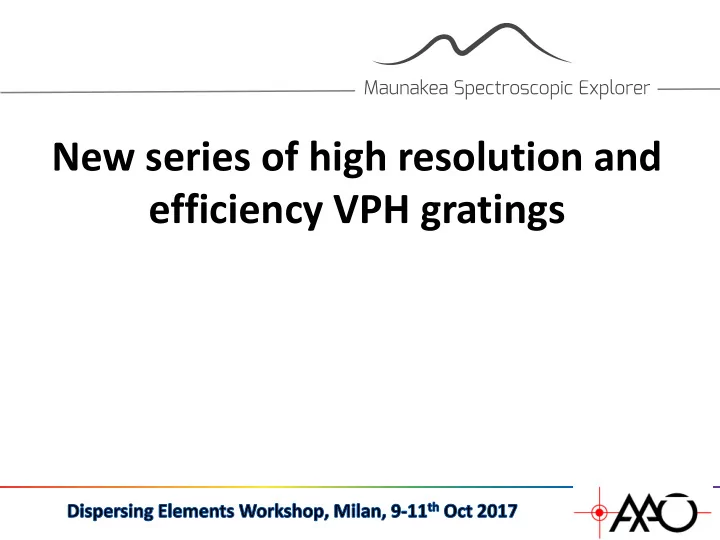

New series of high resolution and efficiency VPH gratings
MSE High Resolution Survey • MSE will include a High Resolution mode for Galactic Archaeology. • 11m telescope, >1000 simultaneous HR spectra, R=40,000, 3 bands. the HR spectrograph costs form a very large fraction of the total. • Would like to use VPHs for MSE, as for HERMES and 4MOST (efficient, tuneable, cheap, robust, Littrow). • But as telescope sizes and resolution requirements increase, are they viable design solutions? 2
Beam Size Spectrograph cost/difficulty/risk strongly 0 driven by the collimated beam size: B = R D T F / ( 2 n 1 tan 0 ) ( R is the resolution, D T is the telescope diameter, F is the angular slit width, n 1 1 is the index of the immersion medium, and 0 is the overall grating angle) 2 B scales directly as R , D T , F All fixed (unless image-slicing used) Larger grating angle is very desirable. But efficiency also paramount! d 3
Diffraction efficiency Peak efficiency of VPH gratings was approximated by Kolgenik (1969): n 2 d n 2 d ½ sin 2 cos 2 2 + ½ sin 2 (1) cos 2 cos 2 ( is the wavelength, n 2 is the index modulation, d the DCG thickness, 2 is the grating angle within the DCG , and the two terms are for s and p polarizations respectively). For each polarization, can get ~100% efficiency by choice of d and n 2 , to get /2 within the brackets * For highest bandwidth, normally want small d and large n 2 * (or 3 /2 or 5 /2 etc). 4
Diffraction efficiency • For small angles, VPH efficiency: 20 cos 2 2 1 , and hence 1.0 excellent peak 0.8 Efficiency efficiency is possible in 0.6 both polarizations 0.4 simultaneously. • But as 2 increases, the 0.2 cos (2 2 ) term 0.0 2 1 0 1 2 introduces a mismatch n d cos between the desired DCG properties for each polarization. 5
Diffraction efficiency • For small angles, VPH efficiency: 30 cos 2 2 1 , and hence 1.0 excellent peak 0.8 Efficiency efficiency is possible in 0.6 both polarizations 0.4 simultaneously. • But as 2 increases, the 0.2 cos (2 2 ) term 0.0 2 1 0 1 2 introduces a mismatch n d cos between the desired DCG properties for each polarization. 6
Diffraction efficiency • Simultaneous high VPH efficiency: 35.3 efficiency for both 1.0 polarizations is still 0.8 Efficiency possible for special 0.6 values of 2 , by 0.4 matching an efficiency peak in the s 0.2 polarization with a 0.0 different peak in the p 2 1 0 1 2 n d cos polarization. ‘Dickson gratings’ 7
Dickson Gratings We need 2 n d cos 2 = 2 a+ 1 (2) and cos2 2 = 2 b + 𝟐 2 a + 𝟐 (3) for integral a , b Simplest Dickson grating has ( a , b ) = (0,1) , 2 = 35.3 , cos2 2 = 1/3 . Matches the 1 st p -polarization peak with the 2 nd s -polarization peak. Leads to overall grating angle ~47 in air for unimmersed grating. Large overall gain for plausible angular bandwidths. 8
Dickson Gratings First astronomical uses of Dickson gratings were for 6dF/RAVE on the UK Schmidt (2003) and AAOmega on the AAT (2004), both for CaII triplet work ( 850nm). Red camera Slit exchange Red grating unit Collimator Blue camera mirror 9
SuperDickson Gratings? Wasatch took a patent on Dickson gratings in 2004, specifically covering a = 0,1,2,3 … and b = 0,1,2,3... Obvious that a must be +ve, from equation (2). However, b is not so constrained, and there are multiple families of further solutions with – ve b. All these new solutions have Bragg angles > 45 . This means they all need prisms to get the light into and out of the grating while avoiding TIR. The two most interesting new classes of gratings are ( a , b ) = (1,-1) and ( a , b ) = (0,-1) . 10
( a , b) = (1,-1), 2 = 54.7 • Matches 1 st p peak with -2 nd s peak. • 0 48 . Gives a dispersion ~50% larger than a classic unimmersed Dickson grating. • DCG parameters look ok – e.g. 5378 lines/mm , n 2 =1.35 0.15, d = 2.37 m . • The FWHM bandwidth is 6.4% in wavelength, or 0.16 rad (9 ) in angle – useable but a bit narrower than we’d like. • Referred to by Baldry et al (2004).
( a , b) = (0,-1), 2 < ~90 2 = 90 is unphysical, but as 2 90 , 1 st s and -1 st p peaks become phased. Design shown has 0 65 , 2 = 72 , 6445 lines/mm, d = 1 m , n =1.4 0.075 FWHM bandwidth is 3.7%, 0.22rad, 12.5 , very nice! The DCG is thinner than used in gratings to date, but the modulation is modest. Larger angles possible but DCG thickness becomes even thinner. 2 nd polarization comes ‘for free’ – almost no loss of bandwidth
Implications for Spectrograph design MSE HR spectrographs require R 40,000 in two arms (~409nm, ~481nm) each with / ~ 1/30 . Telescope is 11m, fiber size MSE 0.8 or FWHM 0.69 . CoDR If classic Dickson gratings used, beam size design is 700mm! New (1,-1) grating, still 450mm. But with (0,-1) grating, B =240mm. 240mm is feasible for KOSI (0,-1) Camera optics sizes not too scary, largest design lenses 300mm (vs 450mm in NIAOT CoDR design). Madrid 27-29 April 2016 13
Recommend
More recommend